mobile View, to the German Version tap the flag


- former Boer's republic of Natalia
- from 1843 British Colony of Natal
- since 1910 province of South Africa
- own names:
– 1839–1843, Afrikaans: Republiek Natalia
– 1843–1910, English: Colony of Natal
– 1910–1994, Afrikaans: Provincie Natal
– since 1994, English: Province of KwaZulu-Natal
• Flags
• Meaning/Origin of the Flag
• Coat of Arms
• Meaning/Origin of the Coat of Arms
• Map
• Numbers and Facts
• History
• Origin of the Country's Name
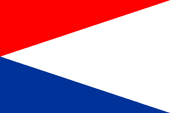
1838–1843,
Republic of Natalia,
National flag,
ratio = 2:3,
Source, by: World Statesmen




1838–1875,
Flag of United Kingdom,
ratio = 1:2





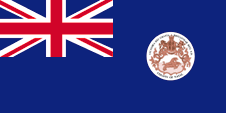
1870–1907,
Flag of the government (state flag),
ratio = 1:2,
Source, by: Flags of the World



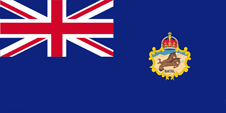
1907–1910,
Flag of the government (state flag),
ratio = 1:2,
Source, by: Flags of the World




The flag of the Republic of Natalia showed the colours red, white and blue in a combination of triangles. The design of the flag was orientated in the colours of the flag of the Netherlands (also called 'Prinsenvlag'), which is however called Van-Riebeeck-Flag in South Africa, because it was used by the early Dutch settlers. After the British conquest in the year 1843, the customary British flag will have been used here, until the introduction of the new British Ensign system and the point of time of its implementation in Natal. United Kingdom introduced a flag system in 1864 in which:
• war ships fly the "White Ensign" (naval flag), a white flag often with an uninterrupted red St. George's-Cross and with the Union Jack in the upper staff quadrant of the flag,
• merchant ships fly a "Red Ensign" (also named "Civil Ensign" → civil flag, the real merchant flag), a red flag with the Union Jack in the upper staff quadrant of the flag, and
• governmental ships fly the "Blue Ensign" (flag for the use by the gouvernment → the actual state flag), a blue flag with the Union Jack in the upper staff quadrant of the flag.
Since 1865 ships of colonial governments were permitted to fly the Blue Ensign with a badge in the flying end of the flag. The respective governments were asked to design appropriate badges. Merchant ships and seafaring persons from colonies were only permitted to use the Red Ensign with a badge, then also named Civil Ensign, if permission has been given to the respective colony by the British admiralty. This was most likely never the case for Natal. Such a badge was often a regional landscape representation placed on a disk, often showing ships, historical events or even a kind of a logo. Very often, a badge also showed the name of the country or a motto. Some British possessions, however, already had a coat of arms from the beginning, or their badge was replaced by a coat of arms over the years. To ensure a uniform appearance in the flying end of the flags, coats of arms and other symbols were displayed on a white disk in the size of the earlier badges. There were also exceptions, because some colonies did not use the white disk and placed their escutcheon or even coat of arms directly on the bunting, sometimes enlarged. Already in the '40s they started to remove the white disk and placed the coat of arms directly or enlarged. This conversion process was done gradually, nowhere at the same time and completely. In some British possessions, flags with the white disc are still in use, in others no more and in some areas are both variants in use, next to each other. The first badge of the British colony introduced in 1870 - placed in the flying end of a "Blue Ensign" - was the rather detailed imprint of the seal of the colony, probably without any colouring, with a surrounding inscription. Probably out of the need for a simplified reproduction, e.g. in print, the badge was greatly simplified in 1907 and reduced to its essential elements: two wildebeests (gnu) and the British crown. Only the country name "Natal" was included as an inscription in the lower part of the badge. As a province of South Africa the country had none own flag anymore since 1910.
Source:
Die Welt der Flaggen,
Wikipedia (EN),
Flags of the World

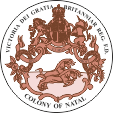
1870–1907,
Badge of Natal,
Source: Flags of the World
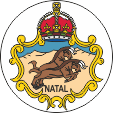
1907–1910,
Badge of Natal,
Source: Flags of the World

The first badge of the British colony introduced in 1870 was the rather detailed imprint of the seal of the colony, probably without any colouring, with a surrounding inscription. Probably out of the need for a simplified reproduction, e.g. in print, the badge was greatly simplified in 1907 and reduced to its essential elements: two wildebeests (gnu) and the British crown. Only the country name "Natal" was included as an inscription in the lower part of the badge.
Source:
Flags of the World

Interactive Map of the Boer's Republics and of the Cape Colony,
today's borders in red:
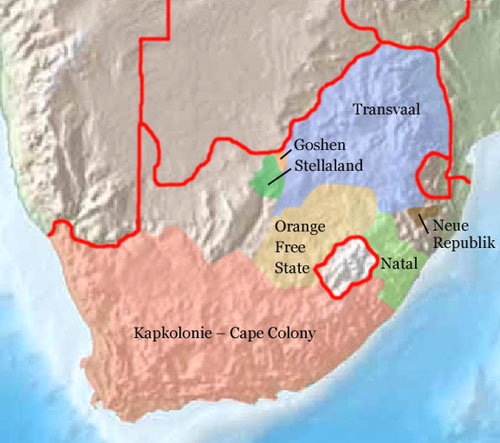
Source: Freeware, University of Texas Libraries, modyfied by: Volker Preuß

Area: 34.710 square miles
Inhabitants: 971.500 (1901)
Capital: Pietermaritzburg, 52.709 inh. (1898)
Languages: Afrikaans, English, Bantu Languages
Time Zone: GMT + 2 h
Source:
Meyers Großes Konversations-Lexikon

1602 · the Netherlanders appropriate the land around the Cape of Good Hope (Kapland), settlement of Boers (farmer of Dutch and German descent, self-designation: Afrikaander)
1652 · Jan van Riebeeck founds the smallholding Kapstadt in mission of the Dutch East Indian Company
1806 · United Kingdom occupys Kapland
1814 · United Kingdom annexes Kapland officially, establishment of the British Cape Colony
1833 · abolition of slavery
1836–1885 · the Boers leave Kapland in long treks towards east and northeast and establish various Boer's republics
1836–1837 · first Boers come in the today's Natal
1838 · establishment of the Republic of Natalia
1843 · United Kingdom conquers the Republic of Natalia, establishment of the Natal Colony, exodus of the Boers
1893 · United Kingdom grants autonomy
1910 · United Kingdom joins the colonies Orange Free State, Transvaal, Natal and Cape Province to the South African Union, status of a British dominion for South Africa
27th of April in 1994 · new constitution for South Africa, official abolition of the racial segregation, dissolution of the homelands, membership in the Commonwealth of Nations again, rename of the Province of Natal in "KwaZulu-Natal"
Source:
Atlas zur Geschichte,
World Statesmen,
Discovery '97,
Wikipedia (EN)

"Natal" is Latin and means birth. The name of the country has its roots in the Portugese seafarer Vasco da Gama, who debarked here on 25th of December in 1497 (Christmas, Dies Natalis Christi) on his way to India and gave the coast this name. But the first Boers called the land "Natalia".
Source: Handbuch der geographischen Namen, Volker Preuß


![]()

















